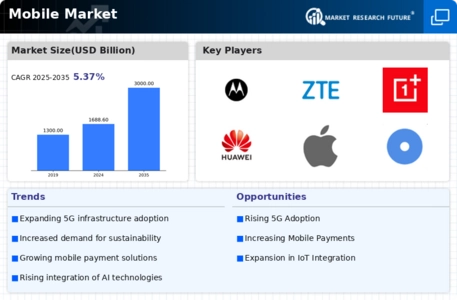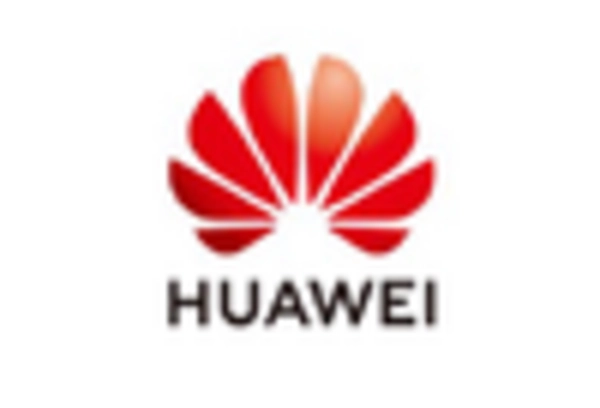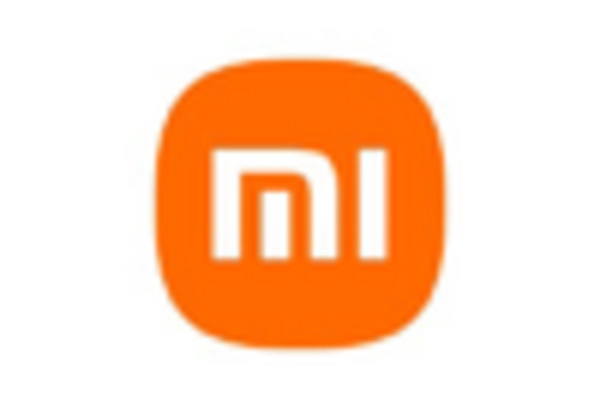-
EXECUTIVE SUMMARY
-
Market Overview
-
Key Findings
-
Market Segmentation
-
Competitive Landscape
-
Challenges and Opportunities
-
Future Outlook
-
MARKET INTRODUCTION
-
Definition
-
Scope of the study
- Research Objective
- Assumption
- Limitations
-
RESEARCH METHODOLOGY
-
Overview
-
Data Mining
-
Secondary Research
-
Primary Research
- Primary Interviews and Information Gathering Process
- Breakdown of Primary Respondents
-
Forecasting Model
-
Market Size Estimation
- Bottom-Up Approach
- Top-Down Approach
-
Data Triangulation
-
Validation
-
MARKET DYNAMICS
-
Overview
-
Drivers
-
Restraints
-
Opportunities
-
MARKET FACTOR ANALYSIS
-
Value chain Analysis
-
Porter's Five Forces Analysis
- Bargaining Power of Suppliers
- Bargaining Power of Buyers
- Threat of New Entrants
- Threat of Substitutes
- Intensity of Rivalry
-
COVID-19 Impact Analysis
- Market Impact Analysis
- Regional Impact
- Opportunity and Threat Analysis
-
Mobile Market, BY Device Type (USD Billion)
-
Smartphones
-
Tablets
-
Wearables
-
Feature Phones
-
Mobile Market, BY Operating System (USD Billion)
-
Android
-
iOS
-
Windows
-
Others
-
Mobile Market, BY Price Range (USD Billion)
-
Economy
-
Mid-Range
-
Premium
-
Mobile Market, BY Distribution Channel (USD Billion)
-
Online
-
Offline
-
Direct Sales
-
Mobile Market, BY Regional (USD Billion)
-
North America
- US
- Canada
-
Europe
- Germany
- UK
- France
- Russia
- Italy
- Spain
- Rest of Europe
-
APAC
- China
- India
- Japan
- South Korea
- Malaysia
- Thailand
- Indonesia
- Rest of APAC
-
South America
- Brazil
- Mexico
- Argentina
- Rest of South America
-
MEA
- GCC Countries
- South Africa
- Rest of MEA
-
Competitive Landscape
-
Overview
-
Competitive Analysis
-
Market share Analysis
-
Major Growth Strategy in the Mobile Market
-
Competitive Benchmarking
-
Leading Players in Terms of Number of Developments in the Mobile Market
-
Key developments and growth strategies
- New Product Launch/Service Deployment
- Merger & Acquisitions
- Joint Ventures
-
Major Players Financial Matrix
- Sales and Operating Income
- Major Players R&D Expenditure. 2023
-
Company Profiles
-
Motorola
- Financial Overview
- Products Offered
- Key Developments
- SWOT Analysis
- Key Strategies
-
ZTE
- Financial Overview
- Products Offered
- Key Developments
- SWOT Analysis
- Key Strategies
-
OnePlus
- Financial Overview
- Products Offered
- Key Developments
- SWOT Analysis
- Key Strategies
-
Huawei
- Financial Overview
- Products Offered
- Key Developments
- SWOT Analysis
- Key Strategies
-
Apple
- Financial Overview
- Products Offered
- Key Developments
- SWOT Analysis
- Key Strategies
-
Oppo
- Financial Overview
- Products Offered
- Key Developments
- SWOT Analysis
- Key Strategies
-
Google
- Financial Overview
- Products Offered
- Key Developments
- SWOT Analysis
- Key Strategies
-
Lenovo
- Financial Overview
- Products Offered
- Key Developments
- SWOT Analysis
- Key Strategies
-
Samsung Electronics
- Financial Overview
- Products Offered
- Key Developments
- SWOT Analysis
- Key Strategies
-
Realme
- Financial Overview
- Products Offered
- Key Developments
- SWOT Analysis
- Key Strategies
-
Vivo
- Financial Overview
- Products Offered
- Key Developments
- SWOT Analysis
- Key Strategies
-
Nokia
- Financial Overview
- Products Offered
- Key Developments
- SWOT Analysis
- Key Strategies
-
Sony
- Financial Overview
- Products Offered
- Key Developments
- SWOT Analysis
- Key Strategies
-
Xiaomi
- Financial Overview
- Products Offered
- Key Developments
- SWOT Analysis
- Key Strategies
-
LG Electronics
- Financial Overview
- Products Offered
- Key Developments
- SWOT Analysis
- Key Strategies
-
Appendix
-
References
-
Related Reports
-
LIST Of tables
-
LIST OF ASSUMPTIONS
-
North America Mobile Market SIZE ESTIMATES & FORECAST, BY DEVICE TYPE, 2019-2035 (USD Billions)
-
North America Mobile Market SIZE ESTIMATES & FORECAST, BY OPERATING SYSTEM, 2019-2035 (USD Billions)
-
North America Mobile Market SIZE ESTIMATES & FORECAST, BY PRICE RANGE, 2019-2035 (USD Billions)
-
North America Mobile Market SIZE ESTIMATES & FORECAST, BY DISTRIBUTION CHANNEL, 2019-2035 (USD Billions)
-
North America Mobile Market SIZE ESTIMATES & FORECAST, BY REGIONAL, 2019-2035 (USD Billions)
-
US Mobile Market SIZE ESTIMATES & FORECAST, BY DEVICE TYPE, 2019-2035 (USD Billions)
-
US Mobile Market SIZE ESTIMATES & FORECAST, BY OPERATING SYSTEM, 2019-2035 (USD Billions)
-
US Mobile Market SIZE ESTIMATES & FORECAST, BY PRICE RANGE, 2019-2035 (USD Billions)
-
US Mobile Market SIZE ESTIMATES & FORECAST, BY DISTRIBUTION CHANNEL, 2019-2035 (USD Billions)
-
US Mobile Market SIZE ESTIMATES & FORECAST, BY REGIONAL, 2019-2035 (USD Billions)
-
Canada Mobile Market SIZE ESTIMATES & FORECAST, BY DEVICE TYPE, 2019-2035 (USD Billions)
-
Canada Mobile Market SIZE ESTIMATES & FORECAST, BY OPERATING SYSTEM, 2019-2035 (USD Billions)
-
Canada Mobile Market SIZE ESTIMATES & FORECAST, BY PRICE RANGE, 2019-2035 (USD Billions)
-
Canada Mobile Market SIZE ESTIMATES & FORECAST, BY DISTRIBUTION CHANNEL, 2019-2035 (USD Billions)
-
Canada Mobile Market SIZE ESTIMATES & FORECAST, BY REGIONAL, 2019-2035 (USD Billions)
-
Europe Mobile Market SIZE ESTIMATES & FORECAST, BY DEVICE TYPE, 2019-2035 (USD Billions)
-
Europe Mobile Market SIZE ESTIMATES & FORECAST, BY OPERATING SYSTEM, 2019-2035 (USD Billions)
-
Europe Mobile Market SIZE ESTIMATES & FORECAST, BY PRICE RANGE, 2019-2035 (USD Billions)
-
Europe Mobile Market SIZE ESTIMATES & FORECAST, BY DISTRIBUTION CHANNEL, 2019-2035 (USD Billions)
-
Europe Mobile Market SIZE ESTIMATES & FORECAST, BY REGIONAL, 2019-2035 (USD Billions)
-
Germany Mobile Market SIZE ESTIMATES & FORECAST, BY DEVICE TYPE, 2019-2035 (USD Billions)
-
Germany Mobile Market SIZE ESTIMATES & FORECAST, BY OPERATING SYSTEM, 2019-2035 (USD Billions)
-
Germany Mobile Market SIZE ESTIMATES & FORECAST, BY PRICE RANGE, 2019-2035 (USD Billions)
-
Germany Mobile Market SIZE ESTIMATES & FORECAST, BY DISTRIBUTION CHANNEL, 2019-2035 (USD Billions)
-
Germany Mobile Market SIZE ESTIMATES & FORECAST, BY REGIONAL, 2019-2035 (USD Billions)
-
UK Mobile Market SIZE ESTIMATES & FORECAST, BY DEVICE TYPE, 2019-2035 (USD Billions)
-
UK Mobile Market SIZE ESTIMATES & FORECAST, BY OPERATING SYSTEM, 2019-2035 (USD Billions)
-
UK Mobile Market SIZE ESTIMATES & FORECAST, BY PRICE RANGE, 2019-2035 (USD Billions)
-
UK Mobile Market SIZE ESTIMATES & FORECAST, BY DISTRIBUTION CHANNEL, 2019-2035 (USD Billions)
-
UK Mobile Market SIZE ESTIMATES & FORECAST, BY REGIONAL, 2019-2035 (USD Billions)
-
France Mobile Market SIZE ESTIMATES & FORECAST, BY DEVICE TYPE, 2019-2035 (USD Billions)
-
France Mobile Market SIZE ESTIMATES & FORECAST, BY OPERATING SYSTEM, 2019-2035 (USD Billions)
-
France Mobile Market SIZE ESTIMATES & FORECAST, BY PRICE RANGE, 2019-2035 (USD Billions)
-
France Mobile Market SIZE ESTIMATES & FORECAST, BY DISTRIBUTION CHANNEL, 2019-2035 (USD Billions)
-
France Mobile Market SIZE ESTIMATES & FORECAST, BY REGIONAL, 2019-2035 (USD Billions)
-
Russia Mobile Market SIZE ESTIMATES & FORECAST, BY DEVICE TYPE, 2019-2035 (USD Billions)
-
Russia Mobile Market SIZE ESTIMATES & FORECAST, BY OPERATING SYSTEM, 2019-2035 (USD Billions)
-
Russia Mobile Market SIZE ESTIMATES & FORECAST, BY PRICE RANGE, 2019-2035 (USD Billions)
-
Russia Mobile Market SIZE ESTIMATES & FORECAST, BY DISTRIBUTION CHANNEL, 2019-2035 (USD Billions)
-
Russia Mobile Market SIZE ESTIMATES & FORECAST, BY REGIONAL, 2019-2035 (USD Billions)
-
Italy Mobile Market SIZE ESTIMATES & FORECAST, BY DEVICE TYPE, 2019-2035 (USD Billions)
-
Italy Mobile Market SIZE ESTIMATES & FORECAST, BY OPERATING SYSTEM, 2019-2035 (USD Billions)
-
Italy Mobile Market SIZE ESTIMATES & FORECAST, BY PRICE RANGE, 2019-2035 (USD Billions)
-
Italy Mobile Market SIZE ESTIMATES & FORECAST, BY DISTRIBUTION CHANNEL, 2019-2035 (USD Billions)
-
Italy Mobile Market SIZE ESTIMATES & FORECAST, BY REGIONAL, 2019-2035 (USD Billions)
-
Spain Mobile Market SIZE ESTIMATES & FORECAST, BY DEVICE TYPE, 2019-2035 (USD Billions)
-
Spain Mobile Market SIZE ESTIMATES & FORECAST, BY OPERATING SYSTEM, 2019-2035 (USD Billions)
-
Spain Mobile Market SIZE ESTIMATES & FORECAST, BY PRICE RANGE, 2019-2035 (USD Billions)
-
Spain Mobile Market SIZE ESTIMATES & FORECAST, BY DISTRIBUTION CHANNEL, 2019-2035 (USD Billions)
-
Spain Mobile Market SIZE ESTIMATES & FORECAST, BY REGIONAL, 2019-2035 (USD Billions)
-
Rest of Europe Mobile Market SIZE ESTIMATES & FORECAST, BY DEVICE TYPE, 2019-2035 (USD Billions)
-
Rest of Europe Mobile Market SIZE ESTIMATES & FORECAST, BY OPERATING SYSTEM, 2019-2035 (USD Billions)
-
Rest of Europe Mobile Market SIZE ESTIMATES & FORECAST, BY PRICE RANGE, 2019-2035 (USD Billions)
-
Rest of Europe Mobile Market SIZE ESTIMATES & FORECAST, BY DISTRIBUTION CHANNEL, 2019-2035 (USD Billions)
-
Rest of Europe Mobile Market SIZE ESTIMATES & FORECAST, BY REGIONAL, 2019-2035 (USD Billions)
-
APAC Mobile Market SIZE ESTIMATES & FORECAST, BY DEVICE TYPE, 2019-2035 (USD Billions)
-
APAC Mobile Market SIZE ESTIMATES & FORECAST, BY OPERATING SYSTEM, 2019-2035 (USD Billions)
-
APAC Mobile Market SIZE ESTIMATES & FORECAST, BY PRICE RANGE, 2019-2035 (USD Billions)
-
APAC Mobile Market SIZE ESTIMATES & FORECAST, BY DISTRIBUTION CHANNEL, 2019-2035 (USD Billions)
-
APAC Mobile Market SIZE ESTIMATES & FORECAST, BY REGIONAL, 2019-2035 (USD Billions)
-
China Mobile Market SIZE ESTIMATES & FORECAST, BY DEVICE TYPE, 2019-2035 (USD Billions)
-
China Mobile Market SIZE ESTIMATES & FORECAST, BY OPERATING SYSTEM, 2019-2035 (USD Billions)
-
China Mobile Market SIZE ESTIMATES & FORECAST, BY PRICE RANGE, 2019-2035 (USD Billions)
-
China Mobile Market SIZE ESTIMATES & FORECAST, BY DISTRIBUTION CHANNEL, 2019-2035 (USD Billions)
-
China Mobile Market SIZE ESTIMATES & FORECAST, BY REGIONAL, 2019-2035 (USD Billions)
-
India Mobile Market SIZE ESTIMATES & FORECAST, BY DEVICE TYPE, 2019-2035 (USD Billions)
-
India Mobile Market SIZE ESTIMATES & FORECAST, BY OPERATING SYSTEM, 2019-2035 (USD Billions)
-
India Mobile Market SIZE ESTIMATES & FORECAST, BY PRICE RANGE, 2019-2035 (USD Billions)
-
India Mobile Market SIZE ESTIMATES & FORECAST, BY DISTRIBUTION CHANNEL, 2019-2035 (USD Billions)
-
India Mobile Market SIZE ESTIMATES & FORECAST, BY REGIONAL, 2019-2035 (USD Billions)
-
Japan Mobile Market SIZE ESTIMATES & FORECAST, BY DEVICE TYPE, 2019-2035 (USD Billions)
-
Japan Mobile Market SIZE ESTIMATES & FORECAST, BY OPERATING SYSTEM, 2019-2035 (USD Billions)
-
Japan Mobile Market SIZE ESTIMATES & FORECAST, BY PRICE RANGE, 2019-2035 (USD Billions)
-
Japan Mobile Market SIZE ESTIMATES & FORECAST, BY DISTRIBUTION CHANNEL, 2019-2035 (USD Billions)
-
Japan Mobile Market SIZE ESTIMATES & FORECAST, BY REGIONAL, 2019-2035 (USD Billions)
-
South Korea Mobile Market SIZE ESTIMATES & FORECAST, BY DEVICE TYPE, 2019-2035 (USD Billions)
-
South Korea Mobile Market SIZE ESTIMATES & FORECAST, BY OPERATING SYSTEM, 2019-2035 (USD Billions)
-
South Korea Mobile Market SIZE ESTIMATES & FORECAST, BY PRICE RANGE, 2019-2035 (USD Billions)
-
South Korea Mobile Market SIZE ESTIMATES & FORECAST, BY DISTRIBUTION CHANNEL, 2019-2035 (USD Billions)
-
South Korea Mobile Market SIZE ESTIMATES & FORECAST, BY REGIONAL, 2019-2035 (USD Billions)
-
Malaysia Mobile Market SIZE ESTIMATES & FORECAST, BY DEVICE TYPE, 2019-2035 (USD Billions)
-
Malaysia Mobile Market SIZE ESTIMATES & FORECAST, BY OPERATING SYSTEM, 2019-2035 (USD Billions)
-
Malaysia Mobile Market SIZE ESTIMATES & FORECAST, BY PRICE RANGE, 2019-2035 (USD Billions)
-
Malaysia Mobile Market SIZE ESTIMATES & FORECAST, BY DISTRIBUTION CHANNEL, 2019-2035 (USD Billions)
-
Malaysia Mobile Market SIZE ESTIMATES & FORECAST, BY REGIONAL, 2019-2035 (USD Billions)
-
Thailand Mobile Market SIZE ESTIMATES & FORECAST, BY DEVICE TYPE, 2019-2035 (USD Billions)
-
Thailand Mobile Market SIZE ESTIMATES & FORECAST, BY OPERATING SYSTEM, 2019-2035 (USD Billions)
-
Thailand Mobile Market SIZE ESTIMATES & FORECAST, BY PRICE RANGE, 2019-2035 (USD Billions)
-
Thailand Mobile Market SIZE ESTIMATES & FORECAST, BY DISTRIBUTION CHANNEL, 2019-2035 (USD Billions)
-
Thailand Mobile Market SIZE ESTIMATES & FORECAST, BY REGIONAL, 2019-2035 (USD Billions)
-
Indonesia Mobile Market SIZE ESTIMATES & FORECAST, BY DEVICE TYPE, 2019-2035 (USD Billions)
-
Indonesia Mobile Market SIZE ESTIMATES & FORECAST, BY OPERATING SYSTEM, 2019-2035 (USD Billions)
-
Indonesia Mobile Market SIZE ESTIMATES & FORECAST, BY PRICE RANGE, 2019-2035 (USD Billions)
-
Indonesia Mobile Market SIZE ESTIMATES & FORECAST, BY DISTRIBUTION CHANNEL, 2019-2035 (USD Billions)
-
Indonesia Mobile Market SIZE ESTIMATES & FORECAST, BY REGIONAL, 2019-2035 (USD Billions)
-
Rest of APAC Mobile Market SIZE ESTIMATES & FORECAST, BY DEVICE TYPE, 2019-2035 (USD Billions)
-
Rest of APAC Mobile Market SIZE ESTIMATES & FORECAST, BY OPERATING SYSTEM, 2019-2035 (USD Billions)
-
Rest of APAC Mobile Market SIZE ESTIMATES & FORECAST, BY PRICE RANGE, 2019-2035 (USD Billions)
-
Rest of APAC Mobile Market SIZE ESTIMATES & FORECAST, BY DISTRIBUTION CHANNEL, 2019-2035 (USD Billions)
-
Rest of APAC Mobile Market SIZE ESTIMATES & FORECAST, BY REGIONAL, 2019-2035 (USD Billions)
-
South America Mobile Market SIZE ESTIMATES & FORECAST, BY DEVICE TYPE, 2019-2035 (USD Billions)
-
South America Mobile Market SIZE ESTIMATES & FORECAST, BY OPERATING SYSTEM, 2019-2035 (USD Billions)
-
South America Mobile Market SIZE ESTIMATES & FORECAST, BY PRICE RANGE, 2019-2035 (USD Billions)
-
South America Mobile Market SIZE ESTIMATES & FORECAST, BY DISTRIBUTION CHANNEL, 2019-2035 (USD Billions)
-
South America Mobile Market SIZE ESTIMATES & FORECAST, BY REGIONAL, 2019-2035 (USD Billions)
-
Brazil Mobile Market SIZE ESTIMATES & FORECAST, BY DEVICE TYPE, 2019-2035 (USD Billions)
-
Brazil Mobile Market SIZE ESTIMATES & FORECAST, BY OPERATING SYSTEM, 2019-2035 (USD Billions)
-
Brazil Mobile Market SIZE ESTIMATES & FORECAST, BY PRICE RANGE, 2019-2035 (USD Billions)
-
Brazil Mobile Market SIZE ESTIMATES & FORECAST, BY DISTRIBUTION CHANNEL, 2019-2035 (USD Billions)
-
Brazil Mobile Market SIZE ESTIMATES & FORECAST, BY REGIONAL, 2019-2035 (USD Billions)
-
Mexico Mobile Market SIZE ESTIMATES & FORECAST, BY DEVICE TYPE, 2019-2035 (USD Billions)
-
Mexico Mobile Market SIZE ESTIMATES & FORECAST, BY OPERATING SYSTEM, 2019-2035 (USD Billions)
-
Mexico Mobile Market SIZE ESTIMATES & FORECAST, BY PRICE RANGE, 2019-2035 (USD Billions)
-
Mexico Mobile Market SIZE ESTIMATES & FORECAST, BY DISTRIBUTION CHANNEL, 2019-2035 (USD Billions)
-
Mexico Mobile Market SIZE ESTIMATES & FORECAST, BY REGIONAL, 2019-2035 (USD Billions)
-
Argentina Mobile Market SIZE ESTIMATES & FORECAST, BY DEVICE TYPE, 2019-2035 (USD Billions)
-
Argentina Mobile Market SIZE ESTIMATES & FORECAST, BY OPERATING SYSTEM, 2019-2035 (USD Billions)
-
Argentina Mobile Market SIZE ESTIMATES & FORECAST, BY PRICE RANGE, 2019-2035 (USD Billions)
-
Argentina Mobile Market SIZE ESTIMATES & FORECAST, BY DISTRIBUTION CHANNEL, 2019-2035 (USD Billions)
-
Argentina Mobile Market SIZE ESTIMATES & FORECAST, BY REGIONAL, 2019-2035 (USD Billions)
-
Rest of South America Mobile Market SIZE ESTIMATES & FORECAST, BY DEVICE TYPE, 2019-2035 (USD Billions)
-
Rest of South America Mobile Market SIZE ESTIMATES & FORECAST, BY OPERATING SYSTEM, 2019-2035 (USD Billions)
-
Rest of South America Mobile Market SIZE ESTIMATES & FORECAST, BY PRICE RANGE, 2019-2035 (USD Billions)
-
Rest of South America Mobile Market SIZE ESTIMATES & FORECAST, BY DISTRIBUTION CHANNEL, 2019-2035 (USD Billions)
-
Rest of South America Mobile Market SIZE ESTIMATES & FORECAST, BY REGIONAL, 2019-2035 (USD Billions)
-
MEA Mobile Market SIZE ESTIMATES & FORECAST, BY DEVICE TYPE, 2019-2035 (USD Billions)
-
MEA Mobile Market SIZE ESTIMATES & FORECAST, BY OPERATING SYSTEM, 2019-2035 (USD Billions)
-
MEA Mobile Market SIZE ESTIMATES & FORECAST, BY PRICE RANGE, 2019-2035 (USD Billions)
-
MEA Mobile Market SIZE ESTIMATES & FORECAST, BY DISTRIBUTION CHANNEL, 2019-2035 (USD Billions)
-
MEA Mobile Market SIZE ESTIMATES & FORECAST, BY REGIONAL, 2019-2035 (USD Billions)
-
GCC Countries Mobile Market SIZE ESTIMATES & FORECAST, BY DEVICE TYPE, 2019-2035 (USD Billions)
-
GCC Countries Mobile Market SIZE ESTIMATES & FORECAST, BY OPERATING SYSTEM, 2019-2035 (USD Billions)
-
GCC Countries Mobile Market SIZE ESTIMATES & FORECAST, BY PRICE RANGE, 2019-2035 (USD Billions)
-
GCC Countries Mobile Market SIZE ESTIMATES & FORECAST, BY DISTRIBUTION CHANNEL, 2019-2035 (USD Billions)
-
GCC Countries Mobile Market SIZE ESTIMATES & FORECAST, BY REGIONAL, 2019-2035 (USD Billions)
-
South Africa Mobile Market SIZE ESTIMATES & FORECAST, BY DEVICE TYPE, 2019-2035 (USD Billions)
-
South Africa Mobile Market SIZE ESTIMATES & FORECAST, BY OPERATING SYSTEM, 2019-2035 (USD Billions)
-
South Africa Mobile Market SIZE ESTIMATES & FORECAST, BY PRICE RANGE, 2019-2035 (USD Billions)
-
South Africa Mobile Market SIZE ESTIMATES & FORECAST, BY DISTRIBUTION CHANNEL, 2019-2035 (USD Billions)
-
South Africa Mobile Market SIZE ESTIMATES & FORECAST, BY REGIONAL, 2019-2035 (USD Billions)
-
Rest of MEA Mobile Market SIZE ESTIMATES & FORECAST, BY DEVICE TYPE, 2019-2035 (USD Billions)
-
Rest of MEA Mobile Market SIZE ESTIMATES & FORECAST, BY OPERATING SYSTEM, 2019-2035 (USD Billions)
-
Rest of MEA Mobile Market SIZE ESTIMATES & FORECAST, BY PRICE RANGE, 2019-2035 (USD Billions)
-
Rest of MEA Mobile Market SIZE ESTIMATES & FORECAST, BY DISTRIBUTION CHANNEL, 2019-2035 (USD Billions)
-
Rest of MEA Mobile Market SIZE ESTIMATES & FORECAST, BY REGIONAL, 2019-2035 (USD Billions)
-
PRODUCT LAUNCH/PRODUCT DEVELOPMENT/APPROVAL
-
ACQUISITION/PARTNERSHIP
-
LIST Of figures
-
MARKET SYNOPSIS
-
NORTH AMERICA MOBILE MARKET ANALYSIS
-
US MOBILE MARKET ANALYSIS BY DEVICE TYPE
-
US MOBILE MARKET ANALYSIS BY OPERATING SYSTEM
-
US MOBILE MARKET ANALYSIS BY PRICE RANGE
-
US MOBILE MARKET ANALYSIS BY DISTRIBUTION CHANNEL
-
US MOBILE MARKET ANALYSIS BY REGIONAL
-
CANADA MOBILE MARKET ANALYSIS BY DEVICE TYPE
-
CANADA MOBILE MARKET ANALYSIS BY OPERATING SYSTEM
-
CANADA MOBILE MARKET ANALYSIS BY PRICE RANGE
-
CANADA MOBILE MARKET ANALYSIS BY DISTRIBUTION CHANNEL
-
CANADA MOBILE MARKET ANALYSIS BY REGIONAL
-
EUROPE MOBILE MARKET ANALYSIS
-
GERMANY MOBILE MARKET ANALYSIS BY DEVICE TYPE
-
GERMANY MOBILE MARKET ANALYSIS BY OPERATING SYSTEM
-
GERMANY MOBILE MARKET ANALYSIS BY PRICE RANGE
-
GERMANY MOBILE MARKET ANALYSIS BY DISTRIBUTION CHANNEL
-
GERMANY MOBILE MARKET ANALYSIS BY REGIONAL
-
UK MOBILE MARKET ANALYSIS BY DEVICE TYPE
-
UK MOBILE MARKET ANALYSIS BY OPERATING SYSTEM
-
UK MOBILE MARKET ANALYSIS BY PRICE RANGE
-
UK MOBILE MARKET ANALYSIS BY DISTRIBUTION CHANNEL
-
UK MOBILE MARKET ANALYSIS BY REGIONAL
-
FRANCE MOBILE MARKET ANALYSIS BY DEVICE TYPE
-
FRANCE MOBILE MARKET ANALYSIS BY OPERATING SYSTEM
-
FRANCE MOBILE MARKET ANALYSIS BY PRICE RANGE
-
FRANCE MOBILE MARKET ANALYSIS BY DISTRIBUTION CHANNEL
-
FRANCE MOBILE MARKET ANALYSIS BY REGIONAL
-
RUSSIA MOBILE MARKET ANALYSIS BY DEVICE TYPE
-
RUSSIA MOBILE MARKET ANALYSIS BY OPERATING SYSTEM
-
RUSSIA MOBILE MARKET ANALYSIS BY PRICE RANGE
-
RUSSIA MOBILE MARKET ANALYSIS BY DISTRIBUTION CHANNEL
-
RUSSIA MOBILE MARKET ANALYSIS BY REGIONAL
-
ITALY MOBILE MARKET ANALYSIS BY DEVICE TYPE
-
ITALY MOBILE MARKET ANALYSIS BY OPERATING SYSTEM
-
ITALY MOBILE MARKET ANALYSIS BY PRICE RANGE
-
ITALY MOBILE MARKET ANALYSIS BY DISTRIBUTION CHANNEL
-
ITALY MOBILE MARKET ANALYSIS BY REGIONAL
-
SPAIN MOBILE MARKET ANALYSIS BY DEVICE TYPE
-
SPAIN MOBILE MARKET ANALYSIS BY OPERATING SYSTEM
-
SPAIN MOBILE MARKET ANALYSIS BY PRICE RANGE
-
SPAIN MOBILE MARKET ANALYSIS BY DISTRIBUTION CHANNEL
-
SPAIN MOBILE MARKET ANALYSIS BY REGIONAL
-
REST OF EUROPE MOBILE MARKET ANALYSIS BY DEVICE TYPE
-
REST OF EUROPE MOBILE MARKET ANALYSIS BY OPERATING SYSTEM
-
REST OF EUROPE MOBILE MARKET ANALYSIS BY PRICE RANGE
-
REST OF EUROPE MOBILE MARKET ANALYSIS BY DISTRIBUTION CHANNEL
-
REST OF EUROPE MOBILE MARKET ANALYSIS BY REGIONAL
-
APAC MOBILE MARKET ANALYSIS
-
CHINA MOBILE MARKET ANALYSIS BY DEVICE TYPE
-
CHINA MOBILE MARKET ANALYSIS BY OPERATING SYSTEM
-
CHINA MOBILE MARKET ANALYSIS BY PRICE RANGE
-
CHINA MOBILE MARKET ANALYSIS BY DISTRIBUTION CHANNEL
-
CHINA MOBILE MARKET ANALYSIS BY REGIONAL
-
INDIA MOBILE MARKET ANALYSIS BY DEVICE TYPE
-
INDIA MOBILE MARKET ANALYSIS BY OPERATING SYSTEM
-
INDIA MOBILE MARKET ANALYSIS BY PRICE RANGE
-
INDIA MOBILE MARKET ANALYSIS BY DISTRIBUTION CHANNEL
-
INDIA MOBILE MARKET ANALYSIS BY REGIONAL
-
JAPAN MOBILE MARKET ANALYSIS BY DEVICE TYPE
-
JAPAN MOBILE MARKET ANALYSIS BY OPERATING SYSTEM
-
JAPAN MOBILE MARKET ANALYSIS BY PRICE RANGE
-
JAPAN MOBILE MARKET ANALYSIS BY DISTRIBUTION CHANNEL
-
JAPAN MOBILE MARKET ANALYSIS BY REGIONAL
-
SOUTH KOREA MOBILE MARKET ANALYSIS BY DEVICE TYPE
-
SOUTH KOREA MOBILE MARKET ANALYSIS BY OPERATING SYSTEM
-
SOUTH KOREA MOBILE MARKET ANALYSIS BY PRICE RANGE
-
SOUTH KOREA MOBILE MARKET ANALYSIS BY DISTRIBUTION CHANNEL
-
SOUTH KOREA MOBILE MARKET ANALYSIS BY REGIONAL
-
MALAYSIA MOBILE MARKET ANALYSIS BY DEVICE TYPE
-
MALAYSIA MOBILE MARKET ANALYSIS BY OPERATING SYSTEM
-
MALAYSIA MOBILE MARKET ANALYSIS BY PRICE RANGE
-
MALAYSIA MOBILE MARKET ANALYSIS BY DISTRIBUTION CHANNEL
-
MALAYSIA MOBILE MARKET ANALYSIS BY REGIONAL
-
THAILAND MOBILE MARKET ANALYSIS BY DEVICE TYPE
-
THAILAND MOBILE MARKET ANALYSIS BY OPERATING SYSTEM
-
THAILAND MOBILE MARKET ANALYSIS BY PRICE RANGE
-
THAILAND MOBILE MARKET ANALYSIS BY DISTRIBUTION CHANNEL
-
THAILAND MOBILE MARKET ANALYSIS BY REGIONAL
-
INDONESIA MOBILE MARKET ANALYSIS BY DEVICE TYPE
-
INDONESIA MOBILE MARKET ANALYSIS BY OPERATING SYSTEM
-
INDONESIA MOBILE MARKET ANALYSIS BY PRICE RANGE
-
INDONESIA MOBILE MARKET ANALYSIS BY DISTRIBUTION CHANNEL
-
INDONESIA MOBILE MARKET ANALYSIS BY REGIONAL
-
REST OF APAC MOBILE MARKET ANALYSIS BY DEVICE TYPE
-
REST OF APAC MOBILE MARKET ANALYSIS BY OPERATING SYSTEM
-
REST OF APAC MOBILE MARKET ANALYSIS BY PRICE RANGE
-
REST OF APAC MOBILE MARKET ANALYSIS BY DISTRIBUTION CHANNEL
-
REST OF APAC MOBILE MARKET ANALYSIS BY REGIONAL
-
SOUTH AMERICA MOBILE MARKET ANALYSIS
-
BRAZIL MOBILE MARKET ANALYSIS BY DEVICE TYPE
-
BRAZIL MOBILE MARKET ANALYSIS BY OPERATING SYSTEM
-
BRAZIL MOBILE MARKET ANALYSIS BY PRICE RANGE
-
BRAZIL MOBILE MARKET ANALYSIS BY DISTRIBUTION CHANNEL
-
BRAZIL MOBILE MARKET ANALYSIS BY REGIONAL
-
MEXICO MOBILE MARKET ANALYSIS BY DEVICE TYPE
-
MEXICO MOBILE MARKET ANALYSIS BY OPERATING SYSTEM
-
MEXICO MOBILE MARKET ANALYSIS BY PRICE RANGE
-
MEXICO MOBILE MARKET ANALYSIS BY DISTRIBUTION CHANNEL
-
MEXICO MOBILE MARKET ANALYSIS BY REGIONAL
-
ARGENTINA MOBILE MARKET ANALYSIS BY DEVICE TYPE
-
ARGENTINA MOBILE MARKET ANALYSIS BY OPERATING SYSTEM
-
ARGENTINA MOBILE MARKET ANALYSIS BY PRICE RANGE
-
ARGENTINA MOBILE MARKET ANALYSIS BY DISTRIBUTION CHANNEL
-
ARGENTINA MOBILE MARKET ANALYSIS BY REGIONAL
-
REST OF SOUTH AMERICA MOBILE MARKET ANALYSIS BY DEVICE TYPE
-
REST OF SOUTH AMERICA MOBILE MARKET ANALYSIS BY OPERATING SYSTEM
-
REST OF SOUTH AMERICA MOBILE MARKET ANALYSIS BY PRICE RANGE
-
REST OF SOUTH AMERICA MOBILE MARKET ANALYSIS BY DISTRIBUTION CHANNEL
-
REST OF SOUTH AMERICA MOBILE MARKET ANALYSIS BY REGIONAL
-
MEA MOBILE MARKET ANALYSIS
-
GCC COUNTRIES MOBILE MARKET ANALYSIS BY DEVICE TYPE
-
GCC COUNTRIES MOBILE MARKET ANALYSIS BY OPERATING SYSTEM
-
GCC COUNTRIES MOBILE MARKET ANALYSIS BY PRICE RANGE
-
GCC COUNTRIES MOBILE MARKET ANALYSIS BY DISTRIBUTION CHANNEL
-
GCC COUNTRIES MOBILE MARKET ANALYSIS BY REGIONAL
-
SOUTH AFRICA MOBILE MARKET ANALYSIS BY DEVICE TYPE
-
SOUTH AFRICA MOBILE MARKET ANALYSIS BY OPERATING SYSTEM
-
SOUTH AFRICA MOBILE MARKET ANALYSIS BY PRICE RANGE
-
SOUTH AFRICA MOBILE MARKET ANALYSIS BY DISTRIBUTION CHANNEL
-
SOUTH AFRICA MOBILE MARKET ANALYSIS BY REGIONAL
-
REST OF MEA MOBILE MARKET ANALYSIS BY DEVICE TYPE
-
REST OF MEA MOBILE MARKET ANALYSIS BY OPERATING SYSTEM
-
REST OF MEA MOBILE MARKET ANALYSIS BY PRICE RANGE
-
REST OF MEA MOBILE MARKET ANALYSIS BY DISTRIBUTION CHANNEL
-
REST OF MEA MOBILE MARKET ANALYSIS BY REGIONAL
-
KEY BUYING CRITERIA OF MOBILE MARKET
-
RESEARCH PROCESS OF MRFR
-
DRO ANALYSIS OF MOBILE MARKET
-
DRIVERS IMPACT ANALYSIS: MOBILE MARKET
-
RESTRAINTS IMPACT ANALYSIS: MOBILE MARKET
-
SUPPLY / VALUE CHAIN: MOBILE MARKET
-
MOBILE MARKET, BY DEVICE TYPE, 2025 (% SHARE)
-
MOBILE MARKET, BY DEVICE TYPE, 2019 TO 2035 (USD Billions)
-
MOBILE MARKET, BY OPERATING SYSTEM, 2025 (% SHARE)
-
MOBILE MARKET, BY OPERATING SYSTEM, 2019 TO 2035 (USD Billions)
-
MOBILE MARKET, BY PRICE RANGE, 2025 (% SHARE)
-
MOBILE MARKET, BY PRICE RANGE, 2019 TO 2035 (USD Billions)
-
MOBILE MARKET, BY DISTRIBUTION CHANNEL, 2025 (% SHARE)
-
MOBILE MARKET, BY DISTRIBUTION CHANNEL, 2019 TO 2035 (USD Billions)
-
MOBILE MARKET, BY REGIONAL, 2025 (% SHARE)
-
MOBILE MARKET, BY REGIONAL, 2019 TO 2035 (USD Billions)
-
BENCHMARKING OF MAJOR COMPETITORS

















Leave a Comment